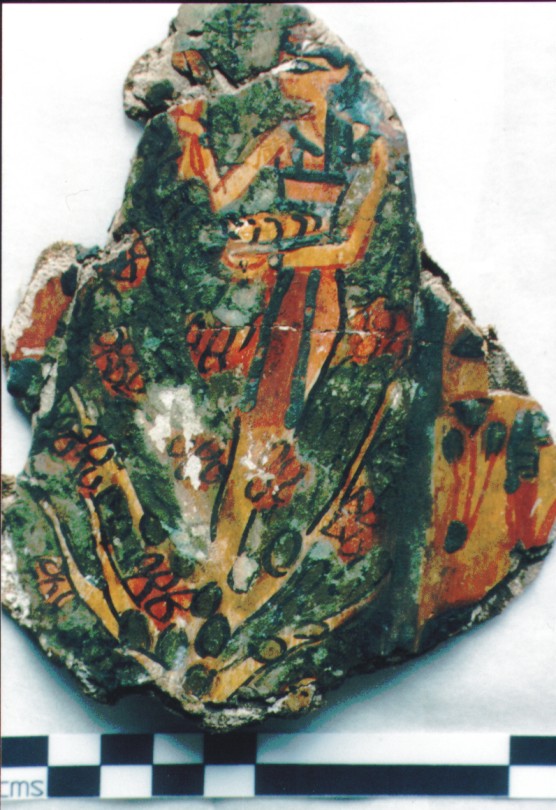EC490
EC490 Cartonnage showing sycamore tree goddess
 A goddess, part woman, part tree on a 21st Dynasty cartonnage. This is a tree goddess. Usually the goddess is Nut but sometwimes she is Hathor or Isis, or the goddess of the west.
A goddess, part woman, part tree on a 21st Dynasty cartonnage. This is a tree goddess. Usually the goddess is Nut but sometwimes she is Hathor or Isis, or the goddess of the west.
This piece of cartonnage shows a tree goddess. While the roots of the idea of the tree goddess go back to the Pyramid Texts (Billing 2002), depictions were not common until the New Kingdom, the first example being in the tomb of Tuthmosis III. You can see another scene of a tree goddess on the 21st Dynasty coffin on display in The House of Death. Usually the goddess is Nut or more rarely Hathor or Isis. The tree was usually the sycamore fig (though the word for sycamore, nht, was used as the general word for ‘tree’). Often the goddess is showing pouring out refreshing liquid into the hands of the deceased while their ba (in the form of a bird with human head) stands close by or flutters in the branches.
Nut the sky goddess was the most common tree goddess.
I am Nut, I have come to thee bringing thee gifts. Thou sittest under me and coolest thyself under me and coolest thyself under my branches. I allow thee to imbibe of my milk and to live and to have nourishment of my two breasts; for joy and health are in them…Thy mother provides thee with life. She sets thee within her womb wherein she conceives….
From the tomb of Kenamun quoted from Alix Wilkinson The Garden In Ancient Egypt
Hathor is the tree goddess of Memphis and is often known as ‘Lady of the sycamore’. According to a New Kingdom story, as ‘Lady of the Sycamore’, she heals the eye of Horus with milk from a gazelle. The juice from the fruit and leaves was milky white and was known by the Egyptians as ‘milk of the sycamore’. It was used to heal wounds and abscesses. Sycamore leaves were used as funerary amulets.
Some representations show the tree in skeletal form from which the goddess rises. There was a long Memphite tradition of a bare sycamore tree in contrast to the fruit bearing tree. The Pyramid Texts describe a tree which shelters the deities with ‘branches dried up, its interior burnt’ Pyramid Text 1485. Moftah (1965: 40-47) and Hermsen (1981: 74-85) associate this bare tree with Hathor, ‘Lady of the Sycamore’, as the Giza necropolis goddess. Examples are discussed in Keel (1992: 86-87).
The tree goddess spell occurs in Chapter 59 of the Book of the Dead. Book of Dead Chapters 109 and 149 – twin ‘sycamores of turquoise’ stood at the eastern gate of heaven from which Re emerged every day. Sometimes such trees appear on New Kingdom tomb paintings with a young bull or calf emerging from them symbolising Re.
The Egypt Centre also holds a 21st Dynasty coffin which has a tree goddess symbol. In this the tree goddess labelled ‘Nut of the west’ stands apart from and in front of the tree and wears what appears to be a feather on her head (the sign is unclear).
Other cartonnage in the Egypt Centre
Other Third Intermediate items in the Egypt Centre
Further Reading
Billing, N. 2002. Nut the goddess of life in text and iconography. Uppsala Studies in Egyptology, 5. Uppsala.
Billing, N. 2004. Writing an Image-The Formulation of the Tree Goddess Motif in the Book of the Dead, Ch. 59. Studien zur Altägyptischen Kultur, 32, 35-50.
Brewer, D. J., Brewer D. B. and Redford, S. 1994. Domestic Plants and Animals: The Egyptian origins. Warminster, Aris & Phillips.
Buhl ML ‘The Goddesses Of The Egyptian Tree Cult’ JNES 6 (1947) 80-97.
Moftah, R. 1965 Die uralt Sykomore und andere Erscheinungen der Hathor. ZAS, 92.
Hermsen, E. 1981. Lebebsbaumsymbolik im alten Ägypten. Köln. E.J. Brill.
Keel, O. 1992. Das Recht der Bilder gesehen zu werden: Drei Fallstudien zur Methode der Interpretation altorientalishcer Bilder. Freiburg and Göttingen, 86-7.